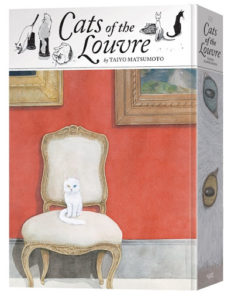A Pair of Comics–Classics and Cats


Long Story Short: 100 Classic Books in Three Panels by Lisa Brown
Cats of the Louvre by Taiyo Matsumoto
I had a chance to reduce my “To Be Read” (TBR) pile by a handful of titles over the holidays, including some comics and graphic novels. Two of the books took an interesting approach using art to comment on other creative works.
Author and illustrator Lisa Brown’s Long Story Short: 100 Classic Books in Three Panels left me in stitches. I love her ability to distill hefty literary works into a trio of illustrated boxes and a sharply-penned sentence. C.S. Lewis’s The Lion, the Witch and the Wardrobe becomes “Don’t take Turkish delight from strangers.” Anne Rice’s Interview with the Vampire is boiled down to “It’s all fun and games until you have a kid.” Upton Sinclair’s The Jungle shows all the gory details of sausage making with a single word in each panel, “DON’T. EAT. MEAT.”
Brown’s pen is equally sharp when it comes to illustrations. She uses india ink on paper then colors digitally with a muted palette of earth tones, grey, and dusty blues, reds, and olive greens. When she uses a bright color–as she does for The Scarlet Letter–it’s with great effect. Picture two panels in drab browns and blacks except for the pop of white collars and a bright red “A” on the subject, “Adulteress” for Hester Prynne and “Apostate” for Rev. Dimmesdale. The payoff is in the last panel bathed in a bright red background with a white “A” for “Aftermath” above Pearl’s blonde hair and bubblegum-pink dress.
Long Story Short packs volumes (and massive spoilers) in only 65 pages. There’s a lot to take in, including amusing cross-references to other chapters. (In case you’re wondering, it’s “horror” for The Jungle.) The book’s well worth a return trip or two or three if only to catch all of the little touches. While it’s no substitute for reading an assignment, Long Story Short works as a humorous accompaniment. Give this book to a favorite English major or someone who appreciates dry wit; suggested for high school and up.
If I were giving the same treatment to my second selection, it would sound something like this, “Paintings are real. Life is surreal. Also cats.” Cats of the Louvre by Taiyo Matsumoto is not about a feline photo shoot or real-life museum cats. It is a gorgeously illustrated, surreal meditation on time and the nature of art itself.
The narrative structure–calling it a plotline is a stretch–weaves multiple stories into a surreal tale following a group of cats living in the museum’s attic, an art conservator restarting her life after a loss, a little girl who has lives in a painting, and a night watchman searching for his sister who mysteriously disappeared in childhood. Each story threads its way through the world of the Louvre where characters intersect with each other and with the art. Dialogue and visual metaphors point to Matsumoto’s thoughts on time’s fleeting nature and art’s immediate and lasting beauty.
Matsumoto’s black and white inkwork looks a lot more like a sketchbook (a refined, very accomplished one) than a graphic novel for a commercial audience. Panel lines appear hand-drawn, slightly uneven and varying in thickness while his shading and crosshatching lend the stories a hazy, dreamlike quality. He creates charming, lifelike cats who take on a slightly disturbing human appearance when the story is told from their point of view. (The effect is not nearly as bad as those in the recent Cats movie.) Adding to the surreal experience are loads of extreme closeups of everything–eyes, faces, hands, paws, paintings, architecture, desktops, papers, art supplies. Even two large cat eyes look out from the book’s spine.
Reading Cats of the Louvre is like stepping into a hushed, contemplative funhouse. It’s weird. It’s surreal. It’s overflowing with metaphors and symbolism and hidden commentary and deep thoughts. It’s not meant to be pigeonholed. There is more than meets the eye; it will reward readers who come with an open mind. A good benchmark might be The Little Prince by Antoine de Saint-Exupery; if you like it, try this title.
Originally a manga (Japanese comic) series, this single-volume, English edition of Cats of the Louvre is accessible as a whole or with a pause after each chapter. Like other manga, it’s meant to be read from right to left and the book begins at what Western books identify as the back cover. Give this title to teens and adults who like the surreal and have the patience to travel over 400 pages of it. Happy reading!











